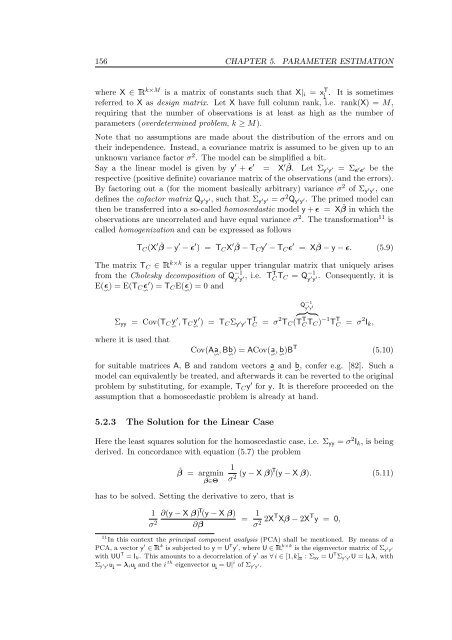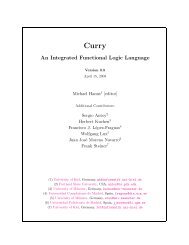Conformal Geometric Algebra in Stochastic Optimization Problems ...
Conformal Geometric Algebra in Stochastic Optimization Problems ...
Conformal Geometric Algebra in Stochastic Optimization Problems ...
You also want an ePaper? Increase the reach of your titles
YUMPU automatically turns print PDFs into web optimized ePapers that Google loves.
156 CHAPTER 5. PARAMETER ESTIMATION<br />
where X ∈ �k×M is a matrix of constants such that X|i = xT i . It is sometimes<br />
referred to X as design matrix. Let X have full column rank, i.e. rank(X) = M,<br />
requir<strong>in</strong>g that the number of observations is at least as high as the number of<br />
parameters (overdeterm<strong>in</strong>ed problem, k ≥ M).<br />
Note that no assumptions are made about the distribution of the errors and on<br />
their <strong>in</strong>dependence. Instead, a covariance matrix is assumed to be given up to an<br />
unknown variance factor σ 2 . The model can be simplified a bit.<br />
Say a the l<strong>in</strong>ear model is given by y ′ + ǫ ′ = X ′ β. ˇ Let Σy ′ y ′ = Σǫ ′ ǫ ′ be the<br />
respective (positive def<strong>in</strong>ite) covariance matrix of the observations (and the errors).<br />
By factor<strong>in</strong>g out a (for the moment basically arbitrary) variance σ2 of Σy ′ y ′, one<br />
def<strong>in</strong>es the cofactor matrix Qy ′ y ′, such that Σy ′ y ′ = σ2Qy ′ y ′. The primed model can<br />
then be transferred <strong>in</strong>to a so-called homoscedastic model y + ǫ = X ˇ β <strong>in</strong> which the<br />
observations are uncorrelated and have equal variance σ2 . The transformation11 is<br />
called homogenization and can be expressed as follows<br />
TC(X ′ ˇ β − y ′ − ǫ ′ ) = TCX ′ ˇ β − TCy ′ − TCǫ ′ = X ˇ β − y − ǫ. (5.9)<br />
The matrix TC ∈ �k×k is a regular upper triangular matrix that uniquely arises<br />
from the Cholesky decomposition of Q −1<br />
y ′ y ′, i.e. TT CTC = Q −1<br />
y ′ y ′. Consequently, it is<br />
′ ) = TCE(ǫ) = 0 and<br />
∽<br />
E(ǫ ∽ ) = E(TCǫ ∽<br />
Σyy = Cov(TC y′ , TC ∽<br />
y ∽<br />
where it is used that<br />
Q −1<br />
y ′ y ′<br />
′<br />
) = TCΣy ′ y ′TTC = σ 2 � �� �<br />
TC(<br />
Cov(Aa ∽ , Bb ∽ ) = ACov(a ∽ , b ∽ )B T<br />
T T CTC) −1 T T C = σ 2 Ik,<br />
(5.10)<br />
for suitable matrices A, B and random vectors a ∽ and b ∽ , confer e.g. [82]. Such a<br />
model can equivalently be treated, and afterwards it can be reverted to the orig<strong>in</strong>al<br />
problem by substitut<strong>in</strong>g, for example, TCy ′ for y. It is therefore proceeded on the<br />
assumption that a homoscedastic problem is already at hand.<br />
5.2.3 The Solution for the L<strong>in</strong>ear Case<br />
Here the least squares solution for the homoscedastic case, i.e. Σyy = σ 2 Ik, is be<strong>in</strong>g<br />
derived. In concordance with equation (5.7) the problem<br />
ˆβ = argm<strong>in</strong><br />
β∈Θ<br />
has to be solved. Sett<strong>in</strong>g the derivative to zero, that is<br />
1<br />
σ 2<br />
∂(y − X β) T (y − X β)<br />
∂β<br />
1<br />
σ 2 (y − X β)T (y − X β). (5.11)<br />
= 1<br />
σ 2 2XT Xβ − 2X T y = 0,<br />
11 In this context the pr<strong>in</strong>cipal component analysis (PCA) shall be mentioned. By means of a<br />
PCA, a vector y ′ ∈ � k is subjected to y = U T y ′ , where U ∈ � k×k is the eigenvector matrix of Σy ′ y ′<br />
with UU T = Ik. This amounts to a decorrelation of y ′ as ∀ i ∈ [1,k] � : Σyy = U T Σy ′ y ′U = Ikλ, with<br />
Σy ′ y ′ui = λiui and the i th eigenvector ui = U| i of Σy ′ y ′.
















